The Initiate
The Egyptian Degrees
 For those of you that think the
Knights Templar
began freemasonry and a process the Mason's call 'Initiation', we did this page.
For those of you that think the
Knights Templar
began freemasonry and a process the Mason's call 'Initiation', we did this page.
Once man's (and woman's too) mind and reason are free from the shackles
of obscurantism, priestly oppression, and anti-scientific narrow-mindedness, humankind will
stroll into a better world.
"My religion consists of a humble admiration of the illimitable superior
spirit who reveals himself in the slight details we are able to perceive with our frail and feeble
mind."
-- Albert Einstein
These mystery school lessons were taught by Pythagoras 300 years before Christ. But we can go back much further than that to stone tablets discovered in Mesopotamia in the 1800's that were written 8000 years ago...before the deluge. Astrology was the main ingredient connected to religion, but science and a resounding respect for nature was also included.
The theory that the mysteries concealed deep truths and remnants of a primitive revelation too profound for the popular mind is no longer believed, but undoubtedly the sacred rituals brought to the initiates secret religious doctrines, which in many instances were concerned with the continuance of life beyond the grave. The mysteries consisted of purifications, sacrificial offerings, processions, songs, dances, and dramatic performances. Often the birth, suffering, death, and resurrection of a god were enacted in dramatic form. The aim of the mysteries seems to have been twofold, namely, to give comfort and moral instruction for life on earth, and to inspire hope for life after death.
One source for the Mystery School teachings is H.P. (Helen) Balvatski. Considered an occultist by some, Helen has been to Tibet and was trained by those masters in Tibet from 1868 to 1870. From 1875 through her death in 1891 she spread that message around the world. The religion that was studied was called 'Bon'. Bon traditions survived under difficult conditions and continued to develop aspects of metaphysics, cosmology, philosophy and an extensive written canon. The influence of Tantric doctrines and Bon make much it more mystical than other forms of Buddhism. There is a strong reliance on mudras (ritual postures), mantras (sacred speech), yantras (sacred art) and secret initiation rites. Often described as the shamanistic and animistic tradition of the Himalayas prior to Buddhism's rise to prominence in the 7th century
The Tibetian religions all believe in reincarnation. This is the key to understanding gnostic principals. Noted philosopher and practicing Buddhist discusses framework basic to philosophy of science and what he considers central to religious experience. The relations among material world, body, mind, and spirit are central. It is also noted in several books that Jesus was in Tibet and studied Buddism. That is proven by many scriptural verses that parallel the Buddah sayings.
The author of Meeting Jesus Again for the First Time uncovers the strange and unexplained parallels among Jesus' sermons and Buddha's sayings. Jesus and Buddha delves into the mysteries surrounding Christ and Buddha, traces the life story and beliefs of both, and then presents their dual teachings in a beautifully formatted fashion.
In the writings of H P Blavatsky who had direct contact with the Brotherhood (the Disciples) we read: "They make it clear that he would rather have lived to continue what he considered his mission, and that he died because he could not help it, and only when betrayed. Before, when threatened with violence, he had made himself invisible by employing the mesmeric power over the bystanders, claimed by every Eastern adept, and escaped. When, finally, he saw that his time had come, he succumbed to the inevitable.
Now this will seem to be completely pagan and blasphemous to some, but it matches the writings in the Nag Hammidi scrolls exactly when we read The Second Treatise of the Great Seth. Theosophy is a fragment of the ancient, once universal, wisdom (gnostic) teaching. The masters of Theosophy, located in Tibet and around the world, preserve and extend this ancient wisdom. Periodically they send forth one of their own - or a messenger - to help spread this teaching to all of humanity. see Sacred Texts
In that world a concern for humanity as a whole is the number one guiding principle in the foreground. In the background is an understanding and command of the hidden laws of nature that is far beyond what is known to humanity in general today.
Theosophy is the name Blavatsky gave to that portion of knowledge that she brought from the masters to the world. It comes from the term "Theosophia" used by the Neoplatonists to mean literally "knowledge of the divine". "An Invitation to the Secret Doctrine." Helpful background and introduction to Blavatsky's magnum opus - the monumental source book for esotericism in our age.
Perhaps all of her work can be summed up in one of her maxims: Compassion is the law of laws. She explained that brotherhood is not a mere ideal - it is a fact in nature on the spiritual plane. From that we derive a logical basis and a binding source for morality that can guide and inspire us, even while more traditional religious sources are losing their compelling force. She gives us the metaphysics from which we can deduce the most important priciples of how to live.
Concerning attacks on Theosophical concepts such as the "seven races" and
"seven globes (heavens)," just keep in mind that the perennial philosophy holds that the highest part
of what makes up a person pre-exists on a higher plane-and will return there after we
cross over. Just remember the old gnostic concept of "seven heavens." Literalism is a
mistake in theosophy, just as it has proven in fundamentalist Christianity. -
S.C. Curtis, April 13, 2002
From the Nag Hammidi Library;
"The resurrection is for the living, not the dead!" This is the real resurrection!
see the Gospel of Philip,
Note; the text does use the word 'christian' but this christianity is not the same as the
commonly excepted version. It refers to a 'pre' christian sect otherwise known as Gnostics.
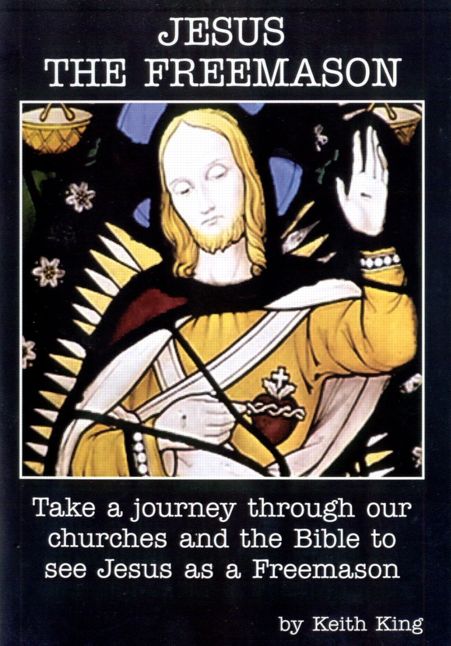 New film: As a small example, St. Thomas, a discipline of Jesus, is always shown with
a carpenter's square, a dominant Masonic symbol. Also, John the Baptist, a well
known patron saint of Freemasonry, was one of Jesus' teachers. Further, Jesus
is often depicted wearing a lambskin, an emblem of innocence and the badge of
a Mason. Fans of Dan Brown's "The Da Vinci Code" will love it because it is filled
with hidden clues about the Craft. Evidence; The Shell is the symbol of the Knights Templar.
St John the Baptist the other Patron Saint of Freemasons, Is always shown baptizing
Jesus with the Shell.
New film: As a small example, St. Thomas, a discipline of Jesus, is always shown with
a carpenter's square, a dominant Masonic symbol. Also, John the Baptist, a well
known patron saint of Freemasonry, was one of Jesus' teachers. Further, Jesus
is often depicted wearing a lambskin, an emblem of innocence and the badge of
a Mason. Fans of Dan Brown's "The Da Vinci Code" will love it because it is filled
with hidden clues about the Craft. Evidence; The Shell is the symbol of the Knights Templar.
St John the Baptist the other Patron Saint of Freemasons, Is always shown baptizing
Jesus with the Shell.
The mysteries of the Shell are not unique to Freemasons, Inside the Shell is the Pearl.
The Buddha who taught Enlightenment 600 years before Jesus, Found the secrets associated
with the Shell, and now every Buddhist Temple displays the Pearl either in the hands of the
Buddha, or within the Dragons mouth.
by W:.Tim Bryce, PM Editor, FREEMASONRY for The Next Generation
We found this link (click the picture) as one of the sponsors of our Esoteric Web Ring.
The Gnostics of the era that Jesus lived could tell you
a different story than the current commonly excepted church invented christian view...Most of
them were killed by the Romans to keep them quite. Current christianity did not exist
until 44AD and the story of Jesus is based on pagan Greek and Roman Gods that we told you about
on Christ's Mission.
For those of you who care to research Greek and Roman culture to see that
this is actually true, visit that page. Jesus' death and resurrection is copied from these sources.
However it might be said that Jesus was just following the ancient traditions
of 'the Gods' and their rituals that originated in Egypt.
That does not in any way say that Jesus was a fake or that he did not
fulfill prophesy. It just says that the real story about his life is not
correctly portrayed in the KJ bible. Miracles?.. Not really.. Lazerus was raised
from a spiritual death not a literal death. The blind made to 'see', yes but not
in a literal sence. Heal the sick?, yes, spirtually sick. The teachings are
allegorical..not literal. 'Born again'...Surprisingly enough this is Literal!.. as in, from the womb
as a child. Another words reincarnation! (We explain this on our 'Hiram's Secret' page) Our Jesus pages
contain some of the real meanings of the allegorical teachings and meanings of phrases he
used. We hope you visit these.
Our main point being, Jesus was an 'initiate'... And this is how it all started.
ANCIENT EGYPTIAN INITIATIONS
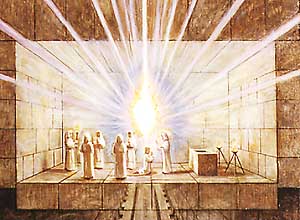 The mysteries and initiations varied from temple to temple. In the Lesser Mysteries
of Isis there is preparatory instruction, meditation within the temple and introduction to
the sanctuary for participation in a performance of drama of death and resurrection.
In today's society, there are many groups that give initiations, but the initiation usually
fails, and usually for the following reasons;.
The mysteries and initiations varied from temple to temple. In the Lesser Mysteries
of Isis there is preparatory instruction, meditation within the temple and introduction to
the sanctuary for participation in a performance of drama of death and resurrection.
In today's society, there are many groups that give initiations, but the initiation usually
fails, and usually for the following reasons;.1. The group doing the initiation does not know enough to do one successfully (usually through lack of full knowledge of their tradition).
2. Incomplete preparation of the Initiate. 3. Incomplete preparation of the group
4. Incomplete Initiatory Ceremonies or process.
5. Initiation Rituals becomes a bad play at best.
6. The people directing the Initiations weren't properly prepared or initiated in their own initiation.
In Egypt, they allowed for self-initiation (but only for some levels). All cognition, after all, comes from the inside. We are therefore initiated only by ourselves, the master or teacher gives us the Key. In some Egyptian initiations the goal is the receive the Sa, the innate virtue or power of the gods as a sort of fluid (or magnetic fluid or aura). It is transmitted by the God's (I will sometimes say God, but take it as either God or Goddess) hands through touch or passes on the neck or spine of the individual. This operation is called the Satapu-sa. "The Summit is the Apex of the Mountains height, but there are both Summit and Valley, hence, something exists which causes both. Equally there is within you that which wants to lift itself despite the animal instincts, and also that which wants to remain earthly. Summit and Valley, are 2 powers manifested. If there were not these two there would be only one. Since there are two there are also all the others which sprang from these, the other Neters or Gods/desses."
"One should pass through complexity in order to exhaust the various possibilities until the
awakening of the consciousness which leads towards simplicity; it is on intermediate
phase between dream and reality." "If the essence and perfection of all good are
comprehended in the god/desses, and if you adhere to a more excellent nature,
you will obtain a union with them, the contemplation of truth, and the posses-
sion of intellect. A knowledge of the gods is accompanied with a conversion
to and knowledge of ourselves." I'll let you contemplate that one for awhile.
Written on the college walls of the Temple of Horus at Edfu. The Egyptian
path can be considered (as defined by Frankfort) as;
1. Evolution =
Ignorance
2 Destruction = Knowledge
3 Dissolution = Experience 4
Reintegration =
Understanding 5 Integration = Wisdom .
seeSacred Texts
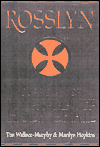
 Portions of this page are exerpts from Rosslyn
By Tim Wallace Murphy and Marilyn Hopkins
Portions of this page are exerpts from Rosslyn
By Tim Wallace Murphy and Marilyn Hopkins The book extensively covers Templar origins and where the rites really came from. This includes the Mystery Schools which we have repeatedly stressed are where Jesus gained his wisdom. We also have a section from The Jesus Papers by Michael Baigent who was co-author of Holy Blood Holy Grail along with Richard Leigh and Henry Lincoln.
We have repeatedly shown that education in mathmetics, alchemy, astronomy, art and music were available prior to 300 BC, in Egypt. When we discussed Abraham, we revealed that he and his wife Sarah taught Geometry to the Egyptians. This was before 1700 BC. We have stressed that education was available to those who would seek it out. The schooling was paid for as a communial project for young leaders who were chosen as soon as they were born. Jesus was from an influential family, with it's member's being of priestly descent. Joseph's family was of the priestly line, all of them being of major importance or having major influence in the community. The Essenes studied Pythagoras a learned scholar and scientist of the 6th century before Jesus was born. Josephus recorded the family history including Jesus' family of which he was a member. They could well afford the schooling and understood it's importance.
Scholars today question the image of Jesus the humble carpenter - and disagree about his social class. They were astounded and said "Where did this man get this wisdom? Is not this the carpenter's son?" The answer is that he was educated by the finest, most brilliant minds in the world. It was then part of his mission to put it all together in the service to the Father.
The family wasn't poor. They just didn't flaunt their wealth or status. But their leadership and community status is well documented in the books of Josephus.
If you have read any of the Jesus pages we reveal that at the age of 7, Jesus entered a school called the The Therapeutae, in Egypt.
Philo described the Therapeutae in the beginning of the 1st century CE in De vita contemplativa ("On the contemplative life"), written ca. 10 CE. By that time, the origins of the Therapeutae were already lost in the past, and Philo was even unsure about the etymology of their name, which he explained as meaning either physicians of souls or servants of God. The opening phrases of his essay establish that it followed one that has been lost, on the active life. Philo was employing the familiar polarity in Hellenic philosophy between the active and the contemplative life, exemplifying the active life by the Essenes, another severely ascetic sect, and the contemplative life by the desert-dwelling Therapeutae.
They "professed an art of healing superior to that practiced in the cities" Philo notes, and the reader must be reminded of the reputation as a healer Saint Anthony possessed among his 4th-century contemporaries, who flocked out from Alexandria to reach him.
Various formative influences on the Therapeutae have been conjectured. The Book of Enoch and Jubilees exemplify the Hebrew tradition for the mystic values of numbers and for allegorical interpretations, without having to reach to Zoroaster or Pythagoreans.
There is a manuscript that was shown to Russian Historian, Nicolai Notovitch written by a Lama of the Hemis Buddhist sect. Jesus' name was known as 'Issa'. He studied the Veda with the Brahmins. The monastery is near Leh, the Capitol of Ledakh in the Himalays of Kasmir. Jesus fled the monastery after he criticized the Caste system.
The idea that Jesus travelled to the then Buddhist Kashmir, they say, can explain these similarities, such as the non-violence and anti-materialistic passages in the Sermon on the Mount. The most important piece of evidence, to him is the Bhavishya Mahapurana, one of the 18 Hindu Puranas. “It provides information that Jesus met the King of Kashmir,” Hassnain says. “He gives his name as Isa-Masih, he says ‘I am known as the Son of God, born of a Virgin’, and he also says he has suffered, meaning, on the cross. The manuscript was in the possession of Maharaja Partap Singh of Kashmir, who later gave it to the Bhandarkar Research Institute, Pune.” Jesus and see The Missing Gospel
Note: The last site is promoting an upcoming Film. Their comment: “Instead of dividing believers, the film will unify Christianity and other religions of the world by clearly presenting the underlying principles they all share,”
This is the Central Theme of Masonry
After finishing schooling in Persia, India and Egypt, he
returned home and became an Essene initiate or member of the 'brotherhood'. The baptism by
John
was his exceptance into the closed community at Qumran and this 'secret society'.
This training took another three years. This training is discussed at length
on Jesus page 2 as it is part of the Dead Sea Scrolls.
see
Masonic rules in the Dead Sea Scrolls
We discuss
The Master Pythagoras
500 years before! More below.
The term esoteric simply means: "designed for or understood by the specially initiated alone". "Relating to knowledge that is restricted to a small group". Those who seek the name of God and are worthy will receive it, but as history has taught us, these are only a few.
If you check out Numbers 6: 1,
you find Moses giving instructions; "When a man or a woman takes
the special vow of a Nazirite, consecrating himself to the Lord
in a special way,...." This proves there was a special sect that
was Jewish but seperate from the rest. These were reserved for
those chosen to fulfill God's priesthood.
Numbers 7: 6 - 16 confirms the priesthood duties and obligations
and... " For, lo, thou shalt conceive and bear
a son, and no razor shall come on his head, for the child shall
be a Nazarite unto God from the womb",
from Judges 13:2-6, referring to the birth of Samson, who would
have also been a student of this sect also. These people were
called 'the Essenes'. Further discussion of them is on
The Real Jesus
In regard to Schonfield's reference to the Nazarenes as "an ancient Israelitish type of religion defying Judean efforts to obliterate it", it is important to note that the term "Judean" refers to southern Israel and especially the orthodox Jewish temple at Jerusalem. Like Schonfield, H.P. Blavatsky demonstrates that the northern Nazarene-Essene religion was much more ancient and authentic than the orthodox Judaism that held power in Yahowshua's day, pre-dating even the authentic versions of the several books of Moses (Moses was attempting to reestablish the Essene Nazarene religion after the captivity) and certainly pre-dating the falsified versions; this she says in her book, 'Isis Unveiled'
"The Narireate [her spelling] sect existed long before the laws of Moses, and originated among the people of Galilee, where was built Nazara, the present Nazareth. It is in Narara that the ancient Nazoria or Nazireates held their "Mysteries of Life"....
Knowing this, and checking other sources, our research has concluded that there was no city of Nazereth in Isreal in Jesus' time. The word was concocted from the term 'Nazirite'. This was a sect, a group of people that originally lived in Egypt. Here they escaped the prosecution of Harod and sent the boys to school. Jesus attended a school of a very old Nazarene sect called Therapeutae, a far older esoteric healing sect who inhabited part of the Nile Delta near Alexanderia. The schools creed was "give me a child until the age of seven and he shall be mine for life". This enunciated from the Jesuits some 1500 years earlier.
Located somewhere close to Alexanderia, this was the site of one of the ancient 'mystery schools'. Other groups included sects that faned out to France, India, and Germany. The early gnostics were called Carpocratians.
Despite his training in the Zealot cause, Jesus, as we have seen, at some point secretly took another path--one revealed only after he had been anointed as messiah, when it was far too late for anybody to challenge him. That path was a more mystical path. Yet where in the Jewish world of Egypt could he have learned such a path. For the answer to this question, we need to look at one of the mystical groups of the time, one described by Philo of Alexandria.
LAKE MARYUT STRETCHES away to the southwest of Alexandria. Between the lake and the sea is a low limestone bill that runs approximately eighteen kilometers from the city walls. During the time of Philo of Alexandria, oil either side of this hill, was lower land that held individual dwellings, perhaps summer villas owned by the rich of Alexandria, and a number of villages and small towns. Because of its proximity to both the lake and the sea, this limestone spur was swept by breezes that kept the air fresh and cooler than the air in the city. On this hill lived a small community of Jewish philosophers who took advantage of the rural peacefulness, the relative security afforded by the nearby villas and towns, and the cool and healthy sea air to devote themselves to lives of contemplation.
This community was given the name of Therapeutae. which, as Philo explains, carries both a sense of healing --not only of the body but also of the soul--- and a sense of worship. Therapeutae worship centered on the “Self-Existent” ----a belief in the One Divine Reality, never created but eternal. This was a concept of divinity far beyond the capability of language to describe.
In one important way, the Therapeutae were very different from the other dedicated groups Philo describes, such as the Essenes. Among the Therapeutae. women were admitted as equal members and participated fully in the spiritual life of the community By contrast, the Essenes, according to Philo, Josephus, and Pliny were proud of the fact that they excluded women; women, they believed, were a distraction. We should recall here the inclusive attitude of Jesus toward the women in his entourage and the criticism that this engendered among some of his male disciples in the Gospels, for there have been many questionable attempts to ally Jesus with the Essenes. Aligned they were because they studied Pythagoras.
The Therapeutae were an elitist community made up apparently of well-educated and wealthy Alexandrians of Philo’s patrician class who had chosen to give up all their possessions and live lives of cornmunal simplicity, dedicated to worship. It seems, from his comments, which have the character of personal experience, that Philo had visited this group and participated in some of their services.
But this group was not alone; Philo describes other such groups dedicated to a type of meditative contemplation throughout all the regions of Egypt. As Philo explains, noting that similar groups coexisted in other parts of the world within other religious traditions, the Therapeutae represented a Jewish version of a widespread mystical tradition that found expression in all lands. The implication of the Therapeutae’s inclusion of women, however, is that when a group is dedicated to the contemplation of the highest experience of the soul to that sight of the soul “which alone gives a knowledge of truth and falsehood” the gender of the worshiper is irrelevant. This may seem self-evident to us todays but in the world of Philo and Jesus this concept was truly revolutionary.
The Therapeutac were mystics and visionaries: “it is well,” Philo writes, “that the Therapeutae, a people always taught from the first to use their sight, should desire the vision of the Existent and soar above the sun of our senses.
Members of the Therapeutae wanted to have a direct vision of reality--or of the “Self-Existent,” to use Philo’s term-in order to experience what truly exists behind the rough-and-tumble world of this transitory life. This too was the aim of many groups operating in the classical world, especially in those great and secret cults called “the Mysteries.” Here we appear to have a Jewish version, seeking the same end, but operating in a much simpler manner within the Jewish tradition.
The Therapeutae prayed at dawn and sunset. During the day they would read the holy texts, but rather than taking these as the history of the Jewish nation, they understood them as allegory. According to Philo, they considered the literal text a symbol of something hidden that they could find only if they looked for it.
Clearly this is a very different type of Judaism, one that does not depend
upon temple worship at all. In Therapeutae worship, which has a very Pythagorean
tinge, there is no concern with the cult of Judaism, which was so important to the
priests in the temples of Jerusalem and the Egyptian delta, or with the purity of the
high priest serving that cult, which was of concern to the Zealots, or with the
coming of the Messiah of the Line of David. For both male and female members
of the Therapeutae, there was simply the possibility of a visionary experience of Divinity.
The Jesus Papers - Michael Baigent
Mysteries (ancient rituals); Secret rites and ceremonies connected with various religious worships of ancient Greece and Rome. These rites and ceremonies were known to, and practiced by, congregations of men and women who had been duly initiated; no other persons were allowed to participate. The origin and purpose of the mysteries are unknown. The theory that the mysteries concealed deep truths and remnants of a primitive revelation too profound for the popular mind is no longer believed, but undoubtedly the sacred rituals brought to the initiates secret religious doctrines, which in many instances were concerned with the continuance of life beyond the grave. The mysteries consisted of purifications, sacrificial offerings, processions, songs, dances, and dramatic performances. Often the birth, suffering, death, and resurrection of a god were enacted in dramatic form. The aim of the mysteries seems to have been twofold, namely, to give comfort and moral instruction for life on earth, and to inspire hope for life after death... from.. Mysteries (ancient rituals)
In the middle ages, many of these mystical teachings were committed to writing in books like the Zohar. Many of these writings were asserted to be secret ancient writings or compilations of secret ancient writings. from. Kabbalah and Jewish Mysticism
Exerpt from The Origin of the Craft; "Pythagoras was a celebrated philosopher who lived in the sixth century before Christ. In the course of his extensive travels through Ionia, Syria, and Egypt, he had been initiated into all the famed mysteries of these kingdoms. It was a desire likely to arise in the mind of such a benevolent and reflective man, to form a perfect system of philosophy, by selecting from the systems into which he had been initiated, whatever seemed peculiarly excellent, and perhaps even improving on them. He settled in Crotona, in Italy, and there, about 550 B.C., founded a fraternity of disciples, called, after him, Pythagoreans."
Josephus, writing between A.D. 75 and A.D. 85, tells us that
the Essenes were Pythagorean in lifestyle.
"The sect of the Essenes maintain that Fate governs all things,
and that nothing can befall man contrary to its determination
and will. These men live the same kind of life which
among the Greeks has been ordered by Pythagoras." see..
The Essenes studied
Pythagoras
At the age of 7 and after the family returned to Jerusalem, Jesus was most likely taught by a tuitor at the Temple school in Jerusalem for the 'chosen ones'. The family had returned from Egypt and this year was used as Jesus' birth year. Jesus was born in March of 6 B.C. He was not born on Dec. 25th. This date was set by the Roman Emperor Constintine to coinside with a pagan Roman god that he worshiped said to be born on that date.
There is a manuscript that was shown to Russian Historian, Nicolai Notovitch written by a Lama of the Hemis Buddhist sect. Jesus' name was known as 'Issa'. He studied the Veda with the Brahmins. The monastery is near Leh, the Capitol of Ledakh in the Himalays of Kasmir. Jesus fled the monastery after he criticized the caste system.
Jesus went to Persia, India and Egypt to Study. In India Jesus studied with the Buddhists in a monastery from the age of 14 until he was 20. He then went to Nepal for 6 more years before returning to Israel at age 29. Jesus was tri-lingual and participated in both the Aramaic and Hebrew culture and its literatures as well as the kind of Hellenistic Greek that he needed to do his business and his ministry.
Since there is no historical record of John the Baptist until his 30th year, we also think he went abroad to take this training.
We are not able to determine when Jesus took the 'priesthood' training but the Mystery School training took 7 years or more. The whole process has been said to take 12 years. Notes on Akhenathen tell us this is called 'right brain' training. We just now are investigating the 'right' side of the brain and what it can do if we apply ourselves. Jesus possibly took the 'priesthood' training after the schooling at India. This would have given him a P.H.D. in this day and age... more on his early years on Jesus, page 3
THE great Theosophist of the first century B.C. was Jesus
the Christ. The great Theosophist of the first century A.D.
was Apollonius of Tyana. The lives of these two men are marked by
striking similarities and by equally striking differences.
The similarities are found in their aim, purpose and teaching,
and are explained by the fact that both were members of that great Fraternity
of Perfected Men who stand behind the Theosophical Movement. The differences are
found in their personal lives and in the way they presented their philosophy.
GREAT THEOSOPHISTS APOLLONIUS OF TYANA
According to the Cayce writings, Jesus did not know who he was until the final test in the
Pyramid of Gaza. This test involved the culmination of all he had learned and studied. The test was the
ultimate preformance of the secrets of alchemy. No one else ever achieved the results that
Jesus attained. This miracle is the result of a complete understanding of Alchemy.
We call this amazing information ..
'The Resurrection'
From the Nag Hammidi Library; "But it happened that after Jesus susposedly had 'risen
from the dead' he spent eleven more years speaking with his disciples.
The term 'raised from the dead' has nothing to do with literal
dying or being brought back to life as such...
Being 'raised from the dead' was a spiritual death and resurrection
which did involve being entombed for 3 days. Only a Priest could
'rescue the initiate' and bring him or her 'back to life'.
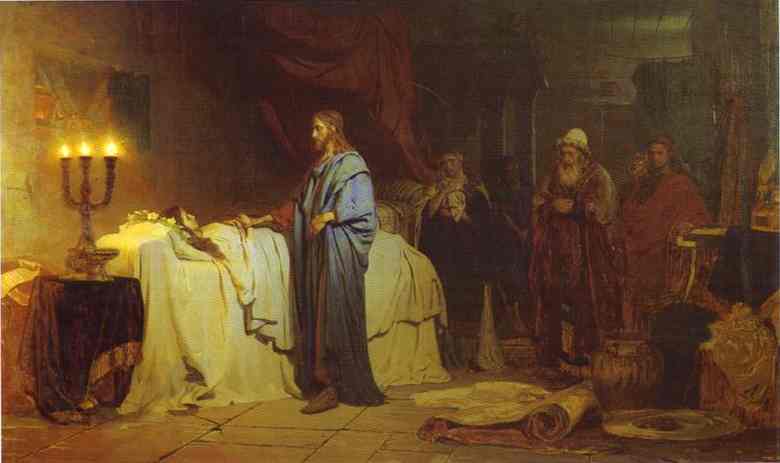 The first mention of Mary in the new Testament is actually
the story of how she was 'raised' from death as (Janus) Jairus' daughter
in AD 17 - Mark 5:37 and Luke 8:51. According to Jacapo (1229-1298) Jairus is actually Syro
the Jairus. He was chief priest (subordinate to the Jerusalem High Priest).
Jarius priestly descent was from the time of David. The priestly line
originated in the Old Testament sons of Jair in the time of Moses.
That was not the Davidic house of Judah, but the priestly Hasmonaean
House of the Maccabees who reigned from 166 BC to 63 BC under general Pompeii.
The first mention of Mary in the new Testament is actually
the story of how she was 'raised' from death as (Janus) Jairus' daughter
in AD 17 - Mark 5:37 and Luke 8:51. According to Jacapo (1229-1298) Jairus is actually Syro
the Jairus. He was chief priest (subordinate to the Jerusalem High Priest).
Jarius priestly descent was from the time of David. The priestly line
originated in the Old Testament sons of Jair in the time of Moses.
That was not the Davidic house of Judah, but the priestly Hasmonaean
House of the Maccabees who reigned from 166 BC to 63 BC under general Pompeii.
The validity of these numerical references to Janus in the symbolism of Entered Apprentice degree has recently been confirmed for me when I discovered a Masonic essay on the two-faced god by Trevor Stewart. In the conclusion to the article he writes:
"Remember also that according to Cicero at least, the name Janus has the same root as the verb ‘to initiate’, and what is it that Freemasons’ Lodges do except they initiate? In other words, they are concerned with ‘beginnings’".
Mary Magdalene or Mary of Bethany (sister of Martha and Lazarus), and the unnamed penitent woman who annointed Jesus's feet (Luke 7:36-48) are sometimes supposed to be the same woman. Peter, James, and her father were the only witnesses of the raising of Jairus's daughter who we think is Mary Magdalene. From this, plus the statement that Jesus had cast seven demons out of her (Luke 8:2), has risen the tradition that she had been a prostitute before she met Jesus. Mary was not a prostitute. It was Pope Gregory in 591 that sealed her fate. He proclaimed that Mary of Bethany and Mary Magdalene to be the same person as detailed in John 11:2. But in the cource of this, he also tackeled the subject if the seven devils, coming to the conclusion that they represented the seven Capital sins. Mary was therefore guilty of pride, envy, glutony, lust, anger, greed and sloth - all seven! It is a wonder that she recovered and that Gregory did not accuse her of the Mortal sins as well! Our page entitled 'Jesus Secret' proves otherwise!
The Tarot Card of 'The High Priestess' is Mary Magdalene. She
was the 'first priest' of the new 'Christian Church'. She was referred to as a 'harlot',
because she was Gnostic.
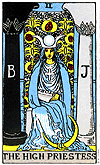 The card hated most by the church was the High Priestess, which was also known as the Papess
or the female Pope. The belief and the reality was that infact Mary Magdalen was the first
spiritual leader of the church, not Peter. She received this authority directly
from Jesus and was the one he loved the most above all the others. This card also is said
to represent the female pope who was a bloodline descendent of Jesus. Four women have
held the distinction of being elected Grand Master of the Priory of Sion and were called Jean
or Jeanne after election.
The card hated most by the church was the High Priestess, which was also known as the Papess
or the female Pope. The belief and the reality was that infact Mary Magdalen was the first
spiritual leader of the church, not Peter. She received this authority directly
from Jesus and was the one he loved the most above all the others. This card also is said
to represent the female pope who was a bloodline descendent of Jesus. Four women have
held the distinction of being elected Grand Master of the Priory of Sion and were called Jean
or Jeanne after election.
Being raised is( symbolically from eternal darkness )(Mark 5:37-42; Luke 8:51),
but Matthew's version differs in one significant
point that cannot be reconciled with the other two without
resorting to typically ridiculous fundamentalist "explanations."
(Matthew 9:18-19, 23-26) "My daughter has just died.".
see Jarius
*(s)he has crossed over from death to life....
related either to elevation of status within the 'Way' or,
as to be released from spiritual death by excommunication.
However, since women were not excommunicated, Mary's event
was plainly an initiatory raising. This form of initiatory raising
from figurative 'death' (darkness) into the degree of community
'life' (light) was part of an ongoing instructional process called
the Way, and was preformed for girls at the age of twelve. First raisings for boys
at fourteen. Gardner The Mary Magdalene Legacy p 12.
Given Mary
was therefore nine years younger than Jesus, making her
twenty-five when she entered her marital contract in AD 30.
(Actually born in 7 BC, He was 36)
see
Jesus' Secret
for more on Mary Madgelene
The 'raising of Lazerus' was the same 'initiation' into the 'brotherhood'. Jesus was not a priest at the time but he did the 'raising' anyway and this was considered 'a miracle'. The secret gospel of Mark seen on Christ's Mission confirms this is true but the original text was edited to hide the truth of the 'real resurrection'.
From the Nag Hammidi.."And he taught them only as far as the places of the first ordinance and as far as the places of the First Mystery, which is within the veil which is within the first ordinance, which is the 24th mystery outside and below , these which are in the second space of the First Mystery, which is before all mysteries of the Father in the form of a dove . And Jesus said to his disciples : "I have come forth from that First Mystery which is the last mystery, namely the 24th"..from The Pistis Sophia
The Egyptian Pilgrimage of Initiation
from Rosslyn, Guardians of the secrets of the Holy Grail
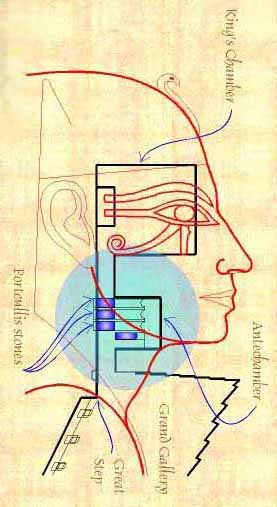 During preparation at Buhen the novice learnt to control his physical appetites and
underwent a prolonged period of purification. This was deemed
to be one of the lesser mysteries, that of the earth.
Throughout all this time he was tested in his emotional
responses, intelligence, willpower and obedience. When he
manifested the required qualities he would undergo final
preparation by being placed in a grotto in complete darkness.
During preparation at Buhen the novice learnt to control his physical appetites and
underwent a prolonged period of purification. This was deemed
to be one of the lesser mysteries, that of the earth.
Throughout all this time he was tested in his emotional
responses, intelligence, willpower and obedience. When he
manifested the required qualities he would undergo final
preparation by being placed in a grotto in complete darkness.
At the Temple of Philae, his eyes were bandaged and he was led to the Gate of Man, where he was asked the password. He was questioned by a master and underwent trails to test his courage. He took his oath of fidelity with a sword at his throat, and only after that were the bandages removed. Before him lay a ladder of seven steps and an allegorical figure portraying eight doors. He ascenced the ladder in the full knowledge that it was an allegeory for the seven stages of alchemical transformation.
He was then awarded the first degree, that of Pastophoris,
taught the hand clasp and the password "Amoun' - be discreet.
Attaining this degree was held to represent the second of
the lesser mysteries, that of Water. The knowledge associated
with it was that of natural sciences, anatomy, healing,
symbology and the common form of hieroglyphic writing.
Mastery of the lesser mystery of the Air was attained at the Temple of Theb es. The candidate had to have undergone at least one year's apprenticeship and then be tested to verify that he had mastered the first degree. To prove that he had acquired control over earthly desires he had to resist the blandishments of Temple Virgins who first served him a delicious feast and the subjected him to sexual temptation. He was then questioned and, if his answers were satisfactory, baptized.
Having manifested both wisdom and chasity he was accepted as a Necoris. After further trials he was given a caduceus, the insignia of the second degree which was also the symbolic staff carried by Mercury, the messanger of the Gods. Here he was taught the word of that degree and given the sign, the arms crossed over the breast. The subjects studied in depth at this level included architecture, geometry, mathmetics, and geographical and other measures of various kinds.
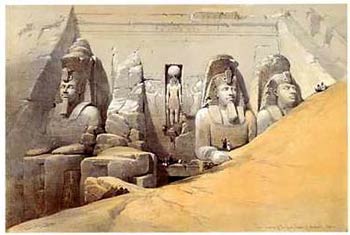 At the Temple of Abydos the candidate was introduced
to the last of the lesser mysteries, that of fire. He
entered an underground chamber by the Gate of Death and
immediately discovered that he was surrounded by mummies,
coffins and those who prepared the dead for their eternal
journey. In the middle of the chamber was a sarcophagus,
the coffin of Osiris, bearing traces of blood. He was told
that Osiris had recently been assassinated and was questioned
as to wheather or not he had any part in the murder.
At the Temple of Abydos the candidate was introduced
to the last of the lesser mysteries, that of fire. He
entered an underground chamber by the Gate of Death and
immediately discovered that he was surrounded by mummies,
coffins and those who prepared the dead for their eternal
journey. In the middle of the chamber was a sarcophagus,
the coffin of Osiris, bearing traces of blood. He was told
that Osiris had recently been assassinated and was questioned
as to wheather or not he had any part in the murder.
On being offered a golden crown the true aspriant refused it as a sign of his distain for material power and wealth. In order to attain the Crown of Truth, he had to throw down the Golden Crown and trample it underfoot. At this, a priest cried "Outrage, vengeance!" and seizing an axe, struck him on the head. The 'dead' candidate was then wrapped in mummy bandages, laid in an open coffin and borne into the sanctuart of the Sprite. Later, in the Hall of Judgement, he was condemned to wander in the underground galleries.
Here he was divested of his mortuary garments and received instruction on death and resurrection. He was then given the sign of the degree, a form of embrace, and the password. The knowledge associated with this degree was artistic, concerning drawing and painting. He was also taught the hierogrammatical alphabet, the history and geography of Egypt, the fundamentals of astronomy and the art of rhetoric.
The candidates who aquired a satisfactory knowledge of the lesser mysteries, and practiced the rites of the third degree satisfactorily for a minium of eighteen months, could then be selected for admission to the first of the greater, spiritual mysteries. This was the fourth degree, which was regarded as the Alpha and the Omega of the pathway to Truth and the Will of God. This opening up of the higher self, or transmutation, was celebrated with great solemnity and ritual at the dual centers of Hermopolis and Akhenaton.
Armed with sword and shield the novice would be led through labyrinthine passages and subjected to attack by masked men carrying flaming torches and serpents. Overcome by these, he would be led, with eyes bandaged and a cord around his neck, into the hall of Maat. There he was raised extended ( a term used by masons today for a ritualized form of resurrection), his bandages were removed and he was introduced to the masters, who were attired in splendid robes and arrayed in order of rank. After an oration, he was ritually armed and presented to the pharoah, who presided over the whole assembly.
He then changed into robes more suited to his new status and had his name inscribed in the book of adepts. From this time on he had gained the priviledge of communication directly with the pharoah and received material and spiritual nourishment from his court. This degree allowed access to the study of the secret language of Ammonitish and the sciences of the human soul in preparation for the final three degrees in which he would learn to use the Word with increasing power.
Such was the importance of the attainment of the fourth degree that it brought with it the absolute right to demand entrance to the fifth at the Temple of Memphis. Here the candidate was led from one assembly to another where he watched others preform a drama which graphically portrayed the conquest of the 100-headed dragon, Typhon, by Horus. The learning that ensued after this degree was in alchemy.
 This mystic death constitutes the fourth initiation,
which consists not only in one's ability to receive
spiritual light, but likewise in one's power to face
with equanimity and awakened morality the darkness
of evil. To become a thing is actually to unite one's
cognizing intelligence with the essence of that being
or thing; in other words, to take on the nature of such
entity for the time being. Hence, to weld one's consciousness
with beings in spheres lower than the human is greatly to
test the stamina of the individual: will the malefic fumes
of the lower spheres stifle the delicate petals of the
budding adept? Will the sensuous delights of the lower
hells have any attraction for the neophyte stern in his
resolve? Conversely, to assume the nature of beings in
spheres higher than the human calls for an equally tempered
constitution: will the brilliance and splendor of truth
undimmed blind the soul? Will vision of reality shatter
the awakening eye of wisdom?
This mystic death constitutes the fourth initiation,
which consists not only in one's ability to receive
spiritual light, but likewise in one's power to face
with equanimity and awakened morality the darkness
of evil. To become a thing is actually to unite one's
cognizing intelligence with the essence of that being
or thing; in other words, to take on the nature of such
entity for the time being. Hence, to weld one's consciousness
with beings in spheres lower than the human is greatly to
test the stamina of the individual: will the malefic fumes
of the lower spheres stifle the delicate petals of the
budding adept? Will the sensuous delights of the lower
hells have any attraction for the neophyte stern in his
resolve? Conversely, to assume the nature of beings in
spheres higher than the human calls for an equally tempered
constitution: will the brilliance and splendor of truth
undimmed blind the soul? Will vision of reality shatter
the awakening eye of wisdom?
This fourth degree may be considered a prelude to, a minor reflection of, the final and seventh degree of initiation in which the individual must undergo the trial of identification with all spheres of being. To complete the full initiatory cycle, therefore, demands the awakening and strengthening of all seven human principles. The candidate must have so tuned his seven-stringed lyre, so energized it with spiritual harmony, that it will vibrate in perfect synchrony with the spiritual essence of the seven principles or spheres of the cosmos. As Master KH wrote in 1882 to Allan O. Hume of Simla, India: "The degrees of an Adept's initiation mark the seven stages at which he discovers the secret of the sevenfold principles in nature and man and awakens his dormant powers" (Mahatma Letters, Letter XV, p. 99).
Of these higher degrees scarcely anything is known to us. This is natural, and indeed appropriate; for how could words describe that which can be understood only by the initiate? How could that which is essentially esoteric be revealed and still retain its mystic integrity? Important hints, however, have been given regarding the fifth, sixth, and seventh degrees.
In the fifth initiation, the initiant "meets his own god-self face to face, and for a longer or shorter time becomes one with it'' (Fundamentals of the Esoteric Philosophy, p. 283). This degree was called by the Greeks theophany, a word signifying "divine appearance" or "showing forth of a divinity," the appearance or manifestation of man's own higher self to himself. And while in the average candidate this sublime moment of intellectual ecstasis and high vision lasted but a short time, with further spiritual progress of the candidate the theophanic communion became more enduring and lasting, until finally, ultimately, man knew himself, not merely as the offspring spiritually of his own inner god, but as that inner god itself, in his essential being. -- Fundamentals of the Esoteric Philosophy, p. 447
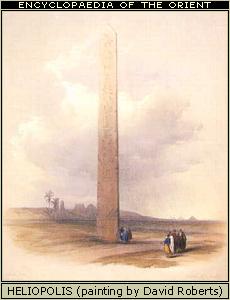 Candidates for the sixth degree were led into the
Temple of Heliopolis and down four steps to the Gate of
Death before being rowed across a flooded crypt in the
Barque of Carnon and presented to the assembly. After
taking the oath of the degree he was instructed in the
history and origin of the gods of Egypt. It was then
explained to him that the entire pantheon of gods emanated
from One God alone. After this he was led up into the
great hall, entering it by the Gate of the Gods. He
would then begin a long period of instruction, studying
the esoteric history of Egypt, the world and the universe.
His long-term aim in this degree was to perfect his
knowledge of astronomy.
Candidates for the sixth degree were led into the
Temple of Heliopolis and down four steps to the Gate of
Death before being rowed across a flooded crypt in the
Barque of Carnon and presented to the assembly. After
taking the oath of the degree he was instructed in the
history and origin of the gods of Egypt. It was then
explained to him that the entire pantheon of gods emanated
from One God alone. After this he was led up into the
great hall, entering it by the Gate of the Gods. He
would then begin a long period of instruction, studying
the esoteric history of Egypt, the world and the universe.
His long-term aim in this degree was to perfect his
knowledge of astronomy.
The sixth initiation was consummated as the inevitable course of events following upon the successful spiritualization of the entire nature. This was called theopneusty by the Greeks -- a word literally signifying "god-breathing" or "divine inspiration" -- where the disciple felt the inbreathing from his own inner god and became, thus, inspired, the very word inspiration meaning "inbreathing." With the passing of time and the greater purification of the soul-vehicle, which is man himself, this inbreathing or inspiration became permanent. -- Ibid. In this degree "the inner god of the candidate breathes down into him, for a longer or shorter time, depending upon his advancement, the wisdom and the knowledge of all the universe . . ."; and "in the sixth degree, instead of one's own Higher Self, the initiant meets another One, . . ." (Fundamentals of the Esoteric Philosophy, pp. 284, 260).
Then comes the seventh and last of the degrees of initiation before masterhood is achieved. This initiation usually took place at the winter solstice. The ancient pagan initiates considered the four points of the year, the winter and summer solstices and the spring and autumnal equinoxes, as representative of holy workings in the cosmos. The birth of the sun at the beginning of the year symbolized to them the mystic birth of the initiate, and it is significant that nearly all the great world saviors, such as Jesus the Christ, Krishna the Avatara, Apollonius of Tyana, and others, celebrate their "birthdays" at this sacred time: the rebirth of the solar deity.
Admission to the ultimate mysteries of Saphenath Pancah, revealed at the seventh and final degree, was granted at the twin temples of Behedet and Heliopolis which represented the dual attributes necessary for the awakening of the crown chakra. These were the ultimate centers of illumination into the pure knowledge of God that has held to be beyond all understanding. Attainment of this degree was far from automatic; the candidate had to be of such outstanding merit that he could be invited by the pharoah with the full consent of the Inner Fraternity.
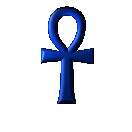 There was a grand reception
for the invited candidate, followed by a public procession,
after which an assembly of the initiates was held during
the hours of darkness in purpose-built houses called Maneras.
Here the new member of the illuminati was given an ambrosial
drink of the gods known as Omellas, and was told that he
had finally arrived at the end of all proofs. He was invested
with the insignia of the Ankh, dressed in a white striped
robe and had his head shaved. The word of this degree was Adon.
There was a grand reception
for the invited candidate, followed by a public procession,
after which an assembly of the initiates was held during
the hours of darkness in purpose-built houses called Maneras.
Here the new member of the illuminati was given an ambrosial
drink of the gods known as Omellas, and was told that he
had finally arrived at the end of all proofs. He was invested
with the insignia of the Ankh, dressed in a white striped
robe and had his head shaved. The word of this degree was Adon.
The most complete and detailed explaination of the supreme mystery was then imparted to the new initiate, or prophet, whereby he gained both the right and the ability to read all the mystical books of Hermes and the scriptures of other nations to which he now had the Royal Key. The Prophet was one who knew all the mysteries and had attained full illumination and union with the divine. His surpreme prerogative was his entitlement to vote in the election of the pharoah. It was also from the ranks of the prophets that all officers of the sacred society were appointed.
The preparation for and the attainment of the seven degrees were part of a continous graded process leading to full illumination.
This seventh degree, which is called theopathy -- a Greek word meaning "god-suffering" or "divine- enduring" -- is the most sublime mystery of all, . . . the initiant, the candidate, suffered himself to become, abandoned himself fully to be, a truly selfless channel of communication of his own inner god, his own higher self; he became lost as it were in the greater self of his own higher self.-- Fundamentals of the Esoteric Philosophy, p. 447
Few indeed are those whose soul strength is so great that they can suffer in fullness the presence of divinity. This is the reward of the highest adepts, those whose sacrifice and wisdom surround humanity with a guardian wall diamond-like in compassion and protection.
In the seventh degree, the neophyte passes the portals of the sun; "he becomes for a passing moment the Wondrous Watcher himself '' (Fundamentals of the Esoteric Philosophy, p. 260). The solar initiation is complete: the neophyte dies, and the hierophant is born.
The Mystery Schools
Jesus, Moses, Abraham, King David and Solomon took this training.
The Mysteries in olden times were regarded so highly that preparation for entrance was deemed the most royal gift a father could bequeath his sons. At the age of seven years, boys were received and disciplined in heart and mind, so that on reaching adulthood they either took their places in the world and exerted an edifying influence among the people; or if they were especially favored by right of inner fitness, they remained within the Sanctuary and passed as far as they could into the Greater Mysteries.
Certain ones were trained for the sole purpose of teaching the laws of life in seats of higher learning; others received the preliminary rites in order to prepare them to govern the State with equanimity and honor. Still others underwent the discipline and purification of the first degrees and then devoted their lives to bringing beauty to mankind, whether in sculpture or color, in verse or harmony. Thus did these early civilizations ripen in spiritual things under the guidance of initiated philosophers and statesmen, artists, and musicians.
Many branches of the arts and sciences were taught in the Lesser Mysteries, notably geography, astronomy, chemistry, physiology, psychology, geology, meteorology, as well as music, the "most divine and spiritual of arts" (Mahatma Letters, Letter XXIVb, p. 188); similarly art and architecture were studied, whose lost "canon of proportion" immortalized the Greek temples. These sciences were held as secret studies of the Mysteries, not because they would not have been understood if taught as schools and universities teach them today, but because such sciences and arts were studied from their causal rather than their effectual aspect.
Much derision has been cast on the ancients for withholding knowledge that even a child can understand in its simpler forms. Certainly the simpler forms were taught openly, but their occult background was kept rigidly secret (as it is even now, though the world at large little dreams of this fact) as fit only for those who would not misuse the knowledge obtained. Can as much wisdom be shown today when, as soon as scientists discover some new device, opportunity is instantly found to turn that invention to destructive uses? One is driven to admire the strength and wisdom of the ancients who knew better than to turn knowledge over indiscriminately to those lacking moral control. With all our boasted superiority, we have not yet caught up on all lines with the scientific knowledge of our ancient forebears.
As H. P. Blavatsky wrote in 1877:
If modern masters are so much in advance of the old ones, why do they not restore to us the lost arts of our postdiluvian forefathers? Why do they not give us the unfading colors of Luxor -- the Tyrian purple; the bright vermilion and dazzling blue which decorate the walls of this place, and are as bright as on the first day of their application?
The indestructible cement of the pyramids and of ancient aqueducts; the Damascus blade, which can be turned like a corkscrew in its scabbard without breaking; the gorgeous, unparalleled tints of the stained glass that is found amid the dust of old ruins and beams in the windows of ancient cathedrals; and the secret of the true malleable glass? And if chemistry is so little able to rival even with the early mediaeval ages in some arts, why boast of achievements which, according to strong probability, were perfectly known thousands of years ago? The more archaeology and philology advance, the more humiliating to our pride are the discoveries which are daily made, the more glorious testimony do they bear in behalf of those who, perhaps on account of the distance of their remote antiquity, have been until now considered ignorant flounderers in the deepest mire of superstition. -- Isis Unveiled 1:239
In the Mysteries, geography was not merely a study of topography; rather the periodical risings and sinkings of continents was the subject of investigation in accordance with the cyclic events of racial history; secret centers of the earth were learned of, and our intimate relation to the two poles and the four points of the compass. HPB suggestively hints:
The two poles are called the right and left ends of our globe -- the right being the North Pole -- or the head and feet of the earth. Every beneficent (astral and cosmic) action comes from the North; every lethal influence from the South Pole. They are much connected with and influence "right" and "left" hand magic.-- Secret Doctrine 2:400n
Meteorology was the study of the currents of wind and rain, not from the effectual standpoint, but as bearing streams of vital energy from all parts of the solar system and beyond. Lightning and thunder, etc., were not merely electromagnetic phenomena -- words that are accurate enough, yet unless occultly understood convey little more than a statement of effects produced. When considered from the causal aspect they are seen to be outer manifestations of interior forces bursting from cosmic space into our atmosphere and affecting the lives of earth.
In Chaldea, Egypt, Mexico and Peru, Wales, Iceland, and India, astrology was regarded with veneration. Its deeper teachings were transmitted from mouth to ear, so sacred and profoundly spiritual were they then considered. Mere fortune-telling and other similar trifles were held vulgar in the eyes of the hierophants. The recognized influences of the sun and planets upon human beings were not viewed as simply mechanical, compelling individuals to this or that character or mode of conduct. Such interchange of planetary and solar life energies among terrestrial beings was understood as springing from our common galactic heritage. The septenary nature of the planets was taken into account in reckoning septenary human nature. Hence the intermingling of life-atoms from the various planetary systems with the earth, and vice versa, constitutes one of the major studies of esoteric astrology.
Furthermore, the science of prediction of tremendous cyclic occurrences on earth was mastered not only in India to a fine hair's breadth (see the Surya-Siddhanta of Asuramaya, the oldest treatise on astronomy extant, Secret Doctrine 2:326), but also in ancient Chaldea, whose modern representatives of some four and five thousand years ago still held archaic astrology as a major characteristic of their secret Mysteries. The famous ziggurat or high tower of Borsippa in Babylonia is clear testimonial to knowledge of the sevenfold planetary influences on humanity. Called the stages of the seven spheres, each of its stories bore a different color, representative of one of the seven sacred planets. At the top of a ziggurat was a sacred shrine, often with a table or couch of gold.
Thus what may have seemed to the public mere astronomical observatories were secret training centers within whose inner recesses esoteric astrology formed one of the important studies of the Lesser Mysteries. Medicine and surgery, physics and alchemy, poetry, mathematics, and philosophy likewise were studied from their inner standpoint. This instruction consists not in the learning by rote of scores of formulae, but in the inner perception of occult rationale, so that knowledge benevolently applied for others may in time become wisdom.
However fascinating to the imagination and of whatever degree of intellectual and psychic stimulation to the neophyte were these studies, they were not the major aim of the Mysteries. Behind all training of the mind was the impelling urge for soul purification through discipline and contemplation. As stimulus and guidance, dramatic presentations were given of the descent of the candidate into the underworld, his trial in the nether regions through meeting and conquering himself, his ascent into the stream of life and light, culminating in final communion and "friendship" with the divinities. So effective were the dramatic rites that participation in them constituted a signal part of the initiatory training in preparation for the Greater Mysteries.
Comparison of the ritual of the Lesser Mysteries, as practiced in the ancient world with slight variations of detail, reveals the universal story of the descent into the underworld in the symbol of the wheat or corn deity. The seed or grain represents the candidate. As the seed enters into the dark regions of the moist earth, many are the difficulties of soil and environment to contend with; it "dies" in giving birth to root and stalk.
Finally, as the period of germination expires, tender shoots of the grain sprout above the surface of the earth, and in time the seed-that-was bursts forth in flower with the aid of sun and rain. In like manner the candidate "dies" in the regions of the underworld, the lower spheres, where he meets and conquers the difficulties of environment; shedding his impermanent self, he dies in giving birth to budding masterhood. At the appropriate hour, the disciple-that-was rises to the spheres of light and life; taken into the presence of other plants of divinity, he finds friendship with the gods and blooms into the full flower of adepthood.
Thus is dramatized in esoteric imagery the spiritual travail of those "giving birth to themselves" (Secret Doctrine 2:559) -- as an ancient manuscript describes the birth of the adept within the neophyte, the supreme initiation.
Continued on The Greater Mysteries
In the deeper Mystery-training, the pupil must not only learn to build the mystic vessel of awakened consciousness which will carry him from plane to plane but, in the process of such individual becoming, must rediscover for himself the ageless routes of initiation.
In wisdom and foresight, nature is consistent throughout: one law, one plan, one structure. With charming thrift she rehearses the pathways of initiation through the cycles of sleep and death. Death and its processes form the heart and core of the Greater Mysteries: through death of the inferior the superior finds birth. Except the seed die, the flower cannot bloom; except the flower die, the seed cannot form. "He that loseth his life for my sake shall find it'' (Matt. 10:39).
Sleep is an incomplete death -- unconsciously experienced; death is a complete sleep -- unconsciously experienced; initiation is a self-conscious sleep or "death'' of the lower elements with a fully conscious liberation of the spiritual soul along the pathways of sleep and death.
In sleep the body "dies" imperfectly, for the golden cord remains linked to the slumbering body. If the soul is not weighted with material desire, then a natural quiescence ensues. During the brief hours of nightly sleep, if the karma be favorable the freed spirit-soul may ascend out of the sphere of earth along the invisible magnetic pathways to higher realms. The ascent is instantaneous, followed by the return along identic pathways until the soul once again enters the sleeping body and a new day dawns.
The pathways of sleep traversed night after night constitute an unconscious journey along the routes of initiation. Such momentary and unrecognized contact during sleep is not wasted; the very repetition of the selfsame process acts as an invisible spur to the ordinary person. If the aspirations continue and the life is made purer, faint impressions of beauty and grandeur will penetrate the soul, intuitions will manifest, and the aspirant will find benediction sweeping into his days through nightly communion with higher spheres.
Death is the following of the same processes of sleep, only perfectly so. The body is cast off permanently and dissipates; the golden cord is withdrawn, and the soul, freed of its terrestrial elements, enters the spheres of temporary purgation. Liberated and cleansed of earthly dross, the soul ascends to its spiritual parent, the higher self, and in peace and bliss undreamed of pursues the identic journey of sleep. In each of the mansions of space, a stop is made, shorter or longer depending upon the links of affinity formerly made through past experience of the spiritual soul until, strengthened by divine contact, it once again treads the ancient pathway, and a child is born on earth.
| Sylvia Brown discusses the Golden Cord in her Book, The Other Side and Back. This book is worth the $7.95 paid for the paperback, to discover there is life after death. |
From the pages of; Atlantis Rising;The prophectic Code of the Pyramid. Marcellinus contemporary, Iamblichus, wrote a treatise on the Mysteries of the Egyptians, and described the Initiation associated with the Sphinx. In a secret location between the paws of the feline monument, he said, is a bronze door, its opening triggered by a hidden spring. Beyond it, the neophytes went into a circular room. From this point on, they were subject to a series of trials to become full members among the Initiates, eventually reaching Masterhood...The Drawing of the interior under the Sphinx is on .. Hall of Records
 The Great Judgement Hall of Maat
also known as Mekhatt which means 'the balance of the Earth'.
The hieroglyphic sign for the verb 'to weigh'
shows a triangle or a 'builders square'. The plumb-bob suspended
from the apex is a sign meaning 'balance the Earth' or
'weighing'. The triangle is also the cross-section of the Pyramid.
The Great Judgement Hall of Maat
also known as Mekhatt which means 'the balance of the Earth'.
The hieroglyphic sign for the verb 'to weigh'
shows a triangle or a 'builders square'. The plumb-bob suspended
from the apex is a sign meaning 'balance the Earth' or
'weighing'. The triangle is also the cross-section of the Pyramid.
Chakra Theory
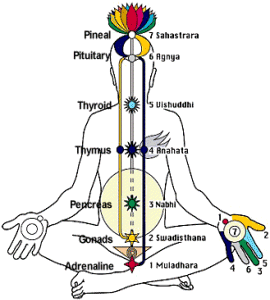 The chakra system can been viewed as a "seven-leveled
philosophical model of the universe." The seven chakras
(Sanskrit for wheels or disks) are wheels of bioenergetic
activity radiating from nerve ganglia (clusters) that start
at the base of the spine and continue on to the crown of the head.
The chakra system can been viewed as a "seven-leveled
philosophical model of the universe." The seven chakras
(Sanskrit for wheels or disks) are wheels of bioenergetic
activity radiating from nerve ganglia (clusters) that start
at the base of the spine and continue on to the crown of the head.
Although the energy of the chakras can be monitored,
they have no mass or substance of their own. Each individual
chakra does, however, have a general location. These locations
are as follows:
Chakra one (earth): Base of spine. Associated with survival.
Chakra two (water): Lower abdomen. Associated with emotions
and sexuality.
Chakra three (fire): Solar plexus. Associated with power and will.
Chakra four (air): Just over the sternum. Associated with love
and balance.
Chakra five (sound): Throat. Associated with communication and
creativity.
Chakra six (light): Center of forehead, brow. Associated with
intuition and imagination.
Chakra seven (thought): Top of head.
Associated with knowledge and understanding. Each of the chakras also denotes one of the eastern elements (shown in parentheses), adding three intangibles to the "standard" four western elements.
As you can see, the lower chakras are more dense and material, while the higher chakras are more "free" and conceptual. It is an eastern belief that this is because they are closer to their source. Beyond the crown is Shiva, the male principal, believed to symbolize pure consciousness and bliss. Beyond the root is Shakti, the female principal, the mother of the universe and creation itself (herself?). By coming together in union, Shiva can descend upon Shakti and bring Divine Consciousness into the universe while Shakti brings form to pure consciousness.
This can be seen in mundane life as well. Ideas (7) become visualized (6) and then shared with others verbally or written down (5). The love of the idea (4) brings one to invest their will and energy into its creation (3). The passion/need (2) to finish this act of creation urges one to provide it form (1) and thus finish the process. We will call this transfer of ideas into form the manifesting current. Consequently, the transfer of form into ideas can be thought of as the liberating current. These two forces are constantly running through the body and connecting the chakras.
Chakras are our energy centers - they are the openings for life energy to flow into and out of our aura. Their function is to vitalize the physical body, to bring about the development of our self-consciousness, and are associated with our physical, mental and emotional interactions. see History of chakra
Chakras are also lines on the ground that connect
spiritual centers. The pyramids of course were set on
these centers and the connecting lines and cities are where the
initiations were carried out for each of the seven degrees..
There are also centers in Europe that
connect Amiens, St. Denis, Notre Dame de Paris, Chartres at
Orleans, Tours, Poitiers, Le Puy and Toulouse. These European
centers were on a line of pilgrimage and initiation for
the Knights Templar. The first degree was at Compostela, the
site of the burial place of James the Just. The seventh and final
degree was given at Rosslyn. Each of the other cities
on the route had a magnificent cathedral built by the
Templars for this purpose. Some of these can be found on this
Search Engine
Here is The Cathredal at Orleans
Chartres
and Notre-Dame de Paris
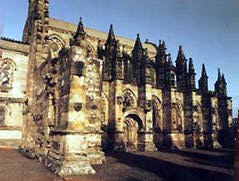 Another very interesting fact is that these sites are
ancient Druidic sites. North of Paris, the sublime architectrue of
Amiens Cathedral is the site of the Drudic oracle of the Jupiter
mysteries. Jupiter is the Latin name for the Father of Light
and the Hebrew name for Jupiter was Zedek, the city-god of
Salem revered by Melchizedek. Jupiter is also described by
Lewis Spence as the father of Kibeiri, a title usually reserved
for Melchizedek. Are Jupiter and Melchizedek the same character
in differing mythological guise?
Another very interesting fact is that these sites are
ancient Druidic sites. North of Paris, the sublime architectrue of
Amiens Cathedral is the site of the Drudic oracle of the Jupiter
mysteries. Jupiter is the Latin name for the Father of Light
and the Hebrew name for Jupiter was Zedek, the city-god of
Salem revered by Melchizedek. Jupiter is also described by
Lewis Spence as the father of Kibeiri, a title usually reserved
for Melchizedek. Are Jupiter and Melchizedek the same character
in differing mythological guise?
This site documents an on-going investigation into the origins of geometry reportedly marked into the landscape in the positions of certain ancient churches, chateaux and mountain peaks around the ancient hilltop village of Rennes-le-Château, France. This project began as an independent attempt to verify or disprove the findings of Henry Lincoln, as published in his book The Holy Place (1991), and more recently in The Key to the Sacred Pattern (1997). The Sacred Landscape Geometry of Rennes-le-chateau
Whatever the truth of this, it was believed that thinking and thus meaningful life itself have their home at the Jupiter oracle; it is the center of true knowledge. The art of Jupiter is rightful speech, for as Mars has formed the word in the air, Jupiter takes it and fills it with divine, spiritual life and vitalizes the form of the body prepared for the next life.
Rosslyn Chapel is the seventh sacred site that lies within the mystical embrase of these two pillers that symbolize the Alpha and the Omega of an ancient pathway of initiation. This is the site revered by the Druids as the oracle of Saturn, the supreme Guardian of Secrets.
More on the planaterary influences on Astrology . This information does site the planets in the solar system as effecting our lives. A free astrology chart link helps us identify our ruling planet and the effects this planet has on our daily lives. We also have more information on the Druids who built the great Stonehenge and the Celts who seem to be the forbearers of the now lost masonic true secrets.
Kabbalah, Qabalah or Cabala.
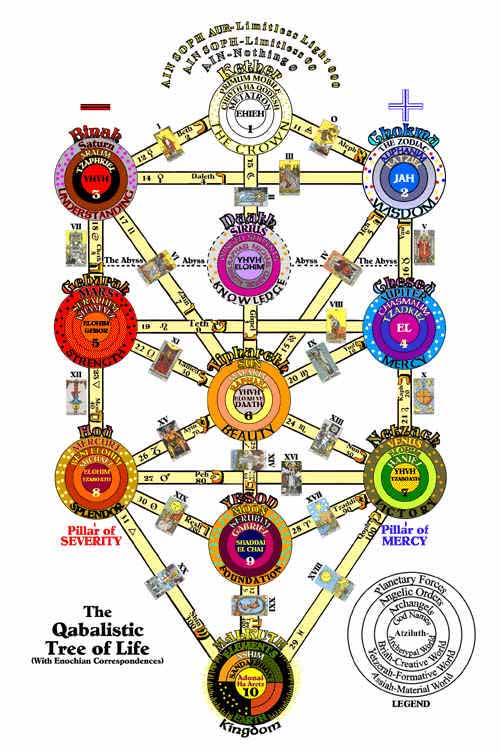 Liberation & Manifestation
Liberation & Manifestation
It comes
from the Hebrew word QBL meaning "oral tradition".
An esoteric and mystical division of Judaism. What the
Kabbalah does is present a symbolic explanation of the origins of the universe.
It shows the relationship of humans to the God with the approach
to creation where the Infinate Light manifests through different Sephiroth
of the Tree of Life.
The Kabbalah has strong links with Gnosticism.
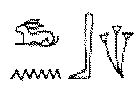 This is a Hieroglyph of the three sacred lotus lilies meaning "Tree of Life". It was
the trunk of the Tree of Life which represented
the World Pillar or Axis Munde (literally "Axis of the Mound")
around which the heavens appeared to revolve. The World Pillar
was the centre of the universe. It was Osiris as the Djed
Pillar, the Pillar of Stability and it was the Great Pyramid of
Egypt.
This is a Hieroglyph of the three sacred lotus lilies meaning "Tree of Life". It was
the trunk of the Tree of Life which represented
the World Pillar or Axis Munde (literally "Axis of the Mound")
around which the heavens appeared to revolve. The World Pillar
was the centre of the universe. It was Osiris as the Djed
Pillar, the Pillar of Stability and it was the Great Pyramid of
Egypt.
"Liberation is the path of transcendence. Manifestation is the path of immanence. Both lead to the same place: the divine" -Anodea Judith, Eastern Body, Western Mind
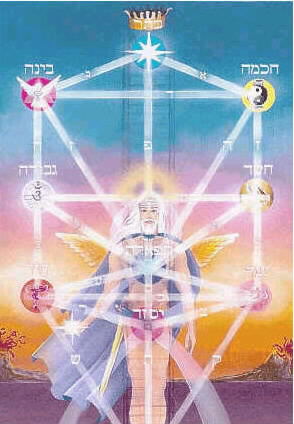 The chakas correspond to The "tree of Life; The centers are arranged in three
columns. The left column is called the Pillar of Severity.
The chakas correspond to The "tree of Life; The centers are arranged in three
columns. The left column is called the Pillar of Severity.
This represents the female side of man and contains three sephira: Binah (Understanding), Geburah (Severity) and Hod (Splendor).
The right column is called the Pillar of Mercy. This represents the male side of man and also contains three sephira: Chokmah (Wisdom), Chesed (Mercy) and Netzach (Victory).
The middle pillar is called the Pillar of Equilibrium. It represents the balance between the male and female pillars. It contains four sephira: Kether (Crown), Tiphareth (Beauty), Yesod (Foundation) and Malkuth (Kingdom).
The Kabbala requires four of these Trees, one for each world of the cosmos. The connections; Winged Discs, Omphalos, Arcs & Archetypes - The ark of the Covenant, Isis - Greek - Egyptian art. more..Tree of Life Kabala
Another important finding..Solomons Temple was based on the
Chakras of man.
see this on
Temple Secrets
Thus the splendor of the whole world will be thine, and all darkness shall flee from thee.
p>This state of unified consciousness can only be symbolised by the absence of darkness, that is, light. That is why this state is called "enlightenment". p>This is the strongest of all powers, the Force of all forces, for it overcometh all subtle things and can penetrate all that is solid.From The secrets of the Emerald Tablet
The Seven Rights
Each of the seven chakras has a basic right that, if infringed upon or not claimed/expressed, can provide problems in that chakra and thus, in life.
1. The right to be here: simply to exist, take care of ourselves, and have possessions.
2. The right to feel: to express and understand one’s emotions, needs, and wants.
3. The right to act: to be innovative and free.
4. The right to love and be loved: freedom from projected or received prejudice,
low self-esteem, and violent conflict. Being the central chakra, if any of the other
rights is harmed, the right to love may be harmed as well.
5. The right to speak and hear truth: Transgressions include: not be listened to,
family secrets, and not being spoken to honestly.
6. The right to see: Transgressions include: being told our perception is inaccurate,
having things deliberately hidden from us, and having the scope of ones vision denied.
7. The right to know: the right to truth, accurate information,
knowledge, and to simply know what’s going on. This includes
spiritual knowledge and the right to connect with and interpret
the divine as one chooses. see..
Chakra Resources
Thus in death the age-old routes of initiation are followed by the spiritual monad in conscious recognition, but as yet in unconscious appreciation by the ordinary human soul.
A human being is many-sided: he has within him a divine monad, a spiritual soul, and a human soul which works through his vital-astral-physical nature. We must guard against the lower gaining dominion over the higher and must watch carefully, particularly in discussion of these holy themes, lest we become so fascinated by their beauty and intellectual splendor, that we forget their essential worth -- that of ethics. Unless an individual has made ethics the foundation of his character, his heart and mind will be continually shaken by the storms of desire.
Those who care for little beyond the immediate will have scant attraction to deeper things, but those who have begun to think and feel intuitively may find themselves irresistibly drawn to the ancient wisdom. However, to those already stirring from the sleep of matter, warning is repeatedly given against entertaining the notion that initiation is just around the corner. One must defend the heart against selfish desire for so-called occult powers as one would defend oneself against the bite of a serpent. The initiations referred to, more particularly in the previous chapter, are not described but only alluded to as hints of what some day the worthy disciple may find himself fortunate enough to experience. from Mysteries 9
More on the real teachings of Jesus and the disciples.. The Gnostic Teachings of Jesus
Search this site
Our search Engine does not search for the links in this site, only words in the text.
NO PART OF THIS SITE MAY BE COPIED OR REPRODUCED, IN WHOLE OR IN PART WITHOUT THE EXPRESS WRITTEN APPROVAL OF THE WEBMASTER. © COPYRIGHT 1999 - 2008 C.I.Case...ALL RIGHTS RESERVED.
If your site is not Masonic in nature, we kindly ask that you do not link
here without permission or under the guidelines set forth here.
..
see Legal Issues
THis page has been visited times since July 1st, 2004.